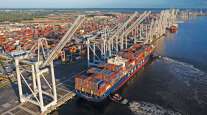Analysis: Trump’s Path to Boosting Infrastructure Full of Potholes

President Donald Trump’s road to getting legislation through Congress this year to restore the nation’s crumbling infrastructure appears increasingly precarious.
Trump has yet to release a plan despite his campaign pledge to create jobs by building bigger and better transportation and other types of infrastructure projects. Administration officials have said a plan will be released in the third quarter of this year, but Congress is unlikely to tackle the issue right away.
Lawmakers will have too much other must-pass legislation on their agenda when they return to work after Labor Day, including deadlines to raise the federal debt limit and, separately, prevent a government shutdown after the current budget year ends on Sept. 30.
After that, Republican leaders plan to revamp tax laws, always difficult and time-consuming.
Even if Congress moves on to infrastructure after taxes, Democrats and many Republicans are skeptical that Trump can reach his goal of generating $1 trillion in infrastructure spending over 10 years if he relies on tax incentives for companies that invest in projects in exchange for the right to collect tolls or other fees and speeding up the environmental permitting process.
Trump has said he’s hopeful Democrats will support his plan. Democrats say they want to work with the administration on infrastructure, but that any bill must include direct funding for projects, not merely tax credits for investors.
“We Democrats sent the president our ‘Better Deal’ infrastructure proposal in January. We still haven’t heard from them,” said Senate Minority Leader Chuck Schumer, (D-N.Y.)
Democrats would pay for their $1 trillion plan with unspecified cuts in tax breaks. In July, Schumer and House Minority Leader Nancy Pelosi, (D-Calif.), made the plan a key part of Democrats’ new economic agenda and messaging strategy for the 2018 midterm elections.
White House officials didn’t reply to questions from The Associated Press.
Trump’s budget proposal submitted to Congress in May called for using $200 billion in government spending to leverage $800 billion in local and private infrastructure investment over 10 years, but didn’t provide details. Trump separately proposed cutting current transportation programs, including eliminating subsidies for Amtrak’s long-distance trains and for scheduled airline service to rural communities, sharply reducing grants for transit capital projects and killing “TIGER” grants for difficult-to-fund transportation projects involving multiple jurisdictions or multiple transportation modes.
A Senate appropriations panel warned in a bipartisan spending bill last month that it “strongly disagrees with the administration’s assertion that providing federal dollars for infrastructure has created ‘an unhealthy dynamic in which state and local governments delay projects in the hope of receiving federal funds.’” Lawmakers were quoting a White House fact sheet on Trump’s infrastructure vision.
The panel also said it is “troubling” that Trump’s budget proposal assumes that after fiscal year 2020, the Highway Trust Fund — which pays for most highway and transit aid — will be limited to revenue from current federal fuel taxes and other user fees. In 2015, Congress shored up the trust fund with general fund money spread over five years. Without a new source of funds, transportation aid would drop by about $95 billion over five years beginning in fiscal 2021.
Some GOP lawmakers and conservative think tanks advocate sharply reducing federal transportation aid, leaving it to states to raise money to cover their transportation needs or not.
Prospects for a bill would improve significantly, lobbyists say, if the tax bill includes proposals for raising money for infrastructure, such as a federal gas tax increase, new trucking fees or lower tax rates for companies that return profits parked overseas to the U.S.
“We see tax reform and infrastructure hopefully going hand-in-hand,” said Sean O’Neill, the Associated General Contractors’ top infrastructure lobbyist.
Gary Cohn, Trump’s top economic adviser, said an infrastructure bill will “come on the heels of taxes.”
“We hope it’s this year,” he told reporters recently. “We need to get taxes done between now and Thanksgiving ... As soon (as) tax comes out of the House and goes to the Senate, we’ll put infrastructure in the House.”
However, it’s far from assured that infrastructure money will be addressed in a tax bill, or that a tax bill can even be passed. Negotiating the bills in a bipartisan way will be critical, said Bud Wright, the American Association of State Highway and Transportation Officials’ executive director.
“It will be difficult to get tax reform or an infrastructure bill over the goal line without Democratic support,” he said. “I want to be optimistic (that an infrastructure bill) can happen, but it’s going to be an uphill climb.”




